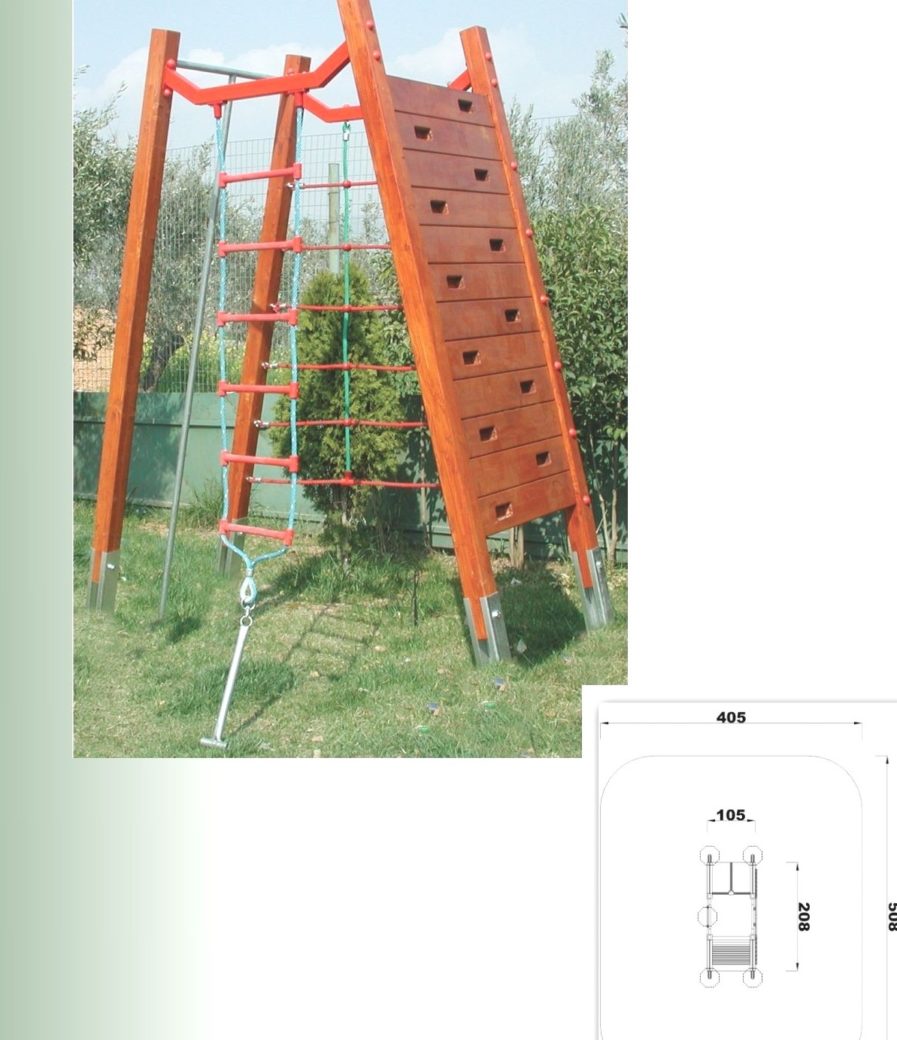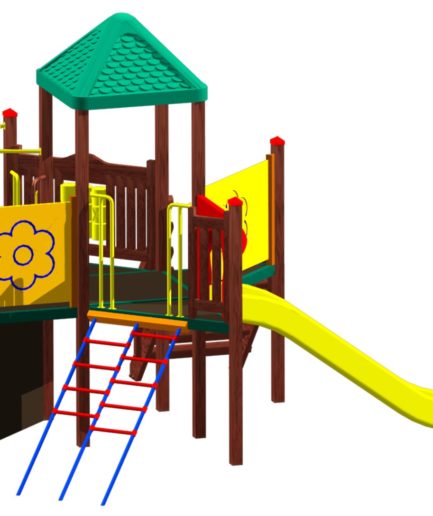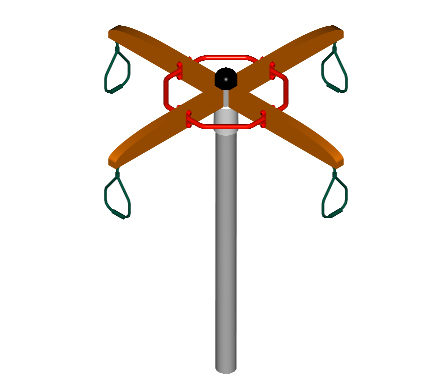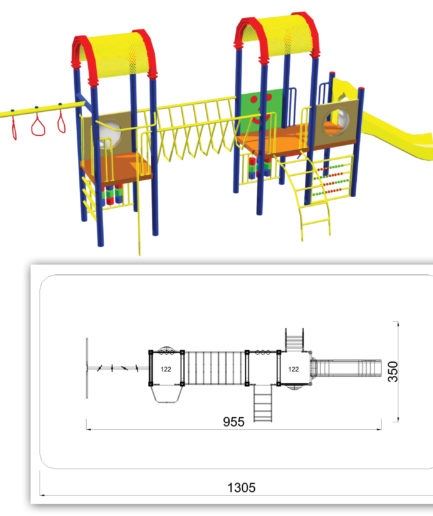CLIMBING FRAMES 000-250
000-250
The wooden climbing instrument has a total dimension of 105X208 cm and a height of 235 cm in the form of a four-sided fractured pyramid with different types of climbing include:
- 1 wooden climbing
- 1 climbing ladder
- 1 climbing net
- 1 climbing tube
- plugs for gears
- Fastening bases
WOODEN CLIMBING
The wooden climbing consists of:
- 2 columns of 9×9 cross section and 240cm long which are dug 174cm at 34.5cm from the bottom with 4cm width and 1.5cm deep digging.
They have a hole Ø17 mm at 8 cm below to connect the mounting bracket.
- 12x 90×14,5×4 wood with 4×12 digging and a depth of 3.5 cm at 20 cm from the edge and in the middle as handles and climbing presses.
The 2 columns are joined to the wood by a spindle and form a climbing side.
CLIMBING LADDER
The climbing ladder consists of:
- 2 columns 9X9 in section and 240 cm in length that are common to the wooden climbing side and to the climbing tube column
- 1 polypropylene (PP) coated cable of 16 mm cross-section 510 cm forming the two sides of the ladder.
- 6 polypropylene (PP) tubular brackets with 27 mm cross-section lengths of 42.5 cm.
- 1 metallic electrostatic paint holder with 4 coupling stand bolts and a coupling between the two wooden pillars of the climbing instrument. It is made of 40x60mm 2mm thick 2mm lightweight 91.5 cm long and 17 cm high.
- T-shaped anchorage system made of Ø1’’ pipe anchored at a depth of 70 cm when mounting the instrument.
The polypropylene coated rope is connected to the 6 polypropylene tubular arms (steps) through their anvils and placed at intervals. The first step is 40 cm above the ground surface and the remaining steps are 25 cm apart. The upper ends of the cable are connected to the metal base in the existing holdings. At the lower end of the ladder the rope forms a loop-loop where the anchor system is joined by a nautical key.
CLIMBING TUBE
The climbing pipe consists of:
- 2 columns 9X9 cross section and 240 cm long
- Vertical climbing hose Ø1 290 cm long of which 70 cm is in the ground when mounting the instrument.
- 80 cm long tube Ø1’’ with 3 mm thick flanges at the ends in which the vertical climbing pipe is welded in the middle.
The two columns are joined together by means of a 80 cm Ø 1’’ tube with spines 13 cm above and forming the side with the climbing tube.
CLIMBING NET
The climbing net consists of:
- 2 9x9cm and 240cm cross columns in common with the wooden climbing side and the climbing tube column with 9 mm holes to support the horizontal lined rails
- 2 polypropylene (PP) coated ropes, 16 mm wide and 165 cm long.
- 6 polypropylene (PP) coated ropes, 16 mm long and 105 cm long, 118 cm, 130 cm, 141 cm, 154 cm, 165 cm respectively.
- 14 M8 thermally galvanized joints.
- 1 metallic electrostatic paint holder with 2 coupling stand bolts and a coupling between the two wooden pillars of the climbing instrument. It is made of 40x60mm 2mm thick 2mm wide open with a length of 91.5cm and a height of 17cm.
- 10 plastic cable joints cross-linked.
- 2 T-shaped plastic joints.
The 2 polypropylene-lined vertical ropes are connected to the 6 polypropylene-lined ropes (steps) through plastic joints that are positioned at intervals. The first polypropylene coated rope ladder is 40 cm from the ground surface and the rest are spaced 26 cm apart. The upper ends of the 2 ropes are connected to the metal base by M8 connectors.
BACKPACK BASES
For fixing the instrument to the ground, each pair has a pair of mounting bases.
The mounting bases consist of two galvanized metal plates and then painted with electrostatic paint, of a shape “P” and approximately 100x12x4 cm thick and 0.5cm thick, which “embrace” the column and are joined by passing screws 5 / 8 ″ X15. At the bottom there is a metal flange to hold them in the concrete pit.
Only ground irons, which hold the column at least 5 cm above the ground, are prevented from being ground in order to prevent the wood from being eroded by soil moisture
TIMBER
The wood used is composite non-stick Swedish pine timber, in accordance with EN 351. It is manufactured with a special compound (welding of wood) in various sections depending on the intended use.
COMPOSITE wood is 40% stronger than whole wood. It has a strength of 360 kp / m2 and a specific weight of about 480 kg / m3.
- Contains about 15% moisture
- Contains minimal juices (resin) compared to other pine family trees in other countries (weather in northern Sweden up to -25 ° C)
- Has thermal conductivity s = 0.10 Kcal / Mho and sound insulation 3.5 times greater than concrete or brick of equal thickness.
- Has antimagnetic properties and is a poor conductor of electricity
- Resistant to fire and classified in categories F30 and F60 (by DIN 4120) according to its cross-section.
- When the outer part of the cross-section burns, its interior protects and retains its durability.
- It is processed just like commercial wood
- Maintains its shape and distorts or creates minimal fractures
- Annual wood rings are usually perpendicular to the long side of the cross-section with a significant increase in the mechanical strength of this surface when applied to floors.
All corners of the wood are planed with a radius of about 5 mm.
PLASTIC INFORMATION
The plastic components required to manufacture the equipment are highly resistant to UV radiation and adverse weather conditions. Preferred are recyclable materials such as polyethylene (PE) or polypropylene (PP). Specifically all screws protruding from the equipment over 5 mm are covered with polypropylene (PP) plastic plugs. They are also safe for the safety and health of children.
METALLIC ELEMENTS
The metallic elements used in the manufacture of the equipment (screws, joints, etc.) are made of metals either thermo-galvanized or electro-galvanized, where the surface preparation has been preceded by sandblasting or stainless steel. The dimensions and cross-sections of the metallic elements are sufficient to accommodate (with an appropriate safety factor) the loads for which they have been designed to withstand corrosion and adverse weather conditions.
PAINTS
The varnishes and the colors that protect the wooden parts are specially designed for the climate of our country (temperature changes, open or closed areas etc.) are absolutely harmless to the users (they do not contain lead, chromium, cadmium and other heavy metals) and give great durability to our constructions.
PACKING
The following procedure is used for fixing the equipment:
At this point where the column is to be installed, a pit about 80 cm deep and 60 cm in diameter is opened. Then, once the column is inserted, the pit is filled with fractured cone-shaped concrete until it reaches 20 cm from the ground surface, where it is covered with soil.
Only ground irons, which hold each column at a distance of about 10 cm from the ground, are prevented on the ground in order to prevent the wood from corroding the soil moisture.
All production work processes for the processing of raw materials are carried out according to:
- EN 1176 standards 1-6,
- ISO 9001: 2015 quality system
- The ISO 14001: 2015 environmental management system






